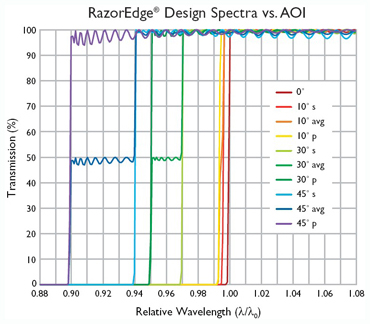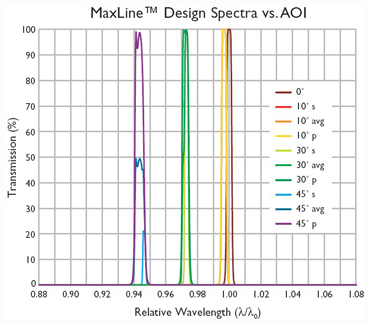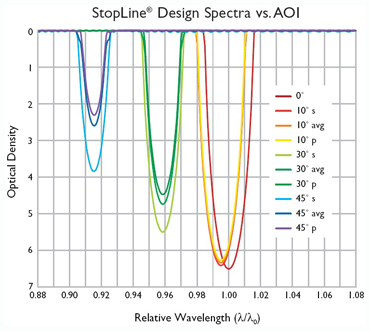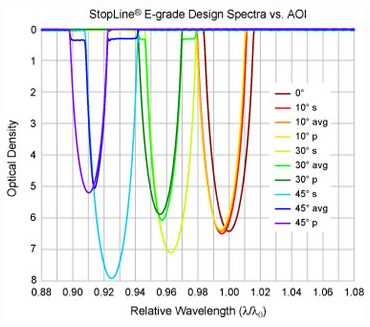Filter Spectra at Non-normal Angles of Incidence
While most applications call for optical filters to be used at normal incidence, it is important to understand how the spectral properties of different types of filters change when using these filters a non-normal angles of incidence (AOI). There are two main effects exhibited by all filter spectrum as the angle is increased from normal:
1. The features of the spectrum shift to shorter wavelengths.
2. Two distinct spectra emerge – one for s-polarized light and one for p-polarized light.
RazorEdge® Edge Filters
The graph on the right (Figure 1) shows a series of spectra derived from a typical RazorEdge long-wave-pass (LWP) filter design, and can be applied to any of the RazorEdge edge filters. Here, the resulting wavelength λ is compared to the wavelength λ0 of the edge location at normal incidence. As the angle increases from normal incidence, the filter edge shifts toward shorter wavelengths and the edges associated with s- and p-polarized light shift by different amounts. For LWP filters, the response of p-polarized light shifts more than s-polarized light. The opposite is true for SWP filters. This polarization splitting causes the unpolarized spectrum to show a "shelf" near the 50% transmission point, but note that the edge steepness remains intact, even for polarized light.
The shift of any spectral feature of a Semrock filter can be calculated using the MyLight tool on the website-based product page. For example, on the product page for the 785 nm RazorEdge long pass filter at 785 nm, click on the MyLight link in the green box. Click here for a tutorial for how to use MyLight. Also note that any catalog filter can also be modeled at specific AOI, CHA, and Polarization in SearchLight.
MaxLine® Laser-line Filters
Varying filter designs will respond to changes in AOI in different ways, but still show marked differences between s- and p-polarized light. The spectra of a MaxLine laser-line filter (Figure 2) shows that as the angle increases from normal incidence, the center wavelength shifts toward shorter wavelengths and the bandwidth broadens slightly for p-polarized light while narrowing for s-polarized light. The most striking feature is the decrease in transmission for s-polarized light, while the p-polarized light maintains high transmission. Use the MyLight Tool described above to model and download spectra of AOI-shifted MaxLine filters, or model them in SearchLight.
StopLine® Notch Filters
The StopLine series of filters has a different response to AOI depending on the grade of filter used. For the standard U- and S-grade filters (Figure 3), as the angle is increased from normal incidence, the notch center wavelength shifts to shorter wavelengths, the notch depth decreases, and the notch bandwidth decreases (with a greater decrease for p-polarized light than for s-polarized light).
E-grade filter (Figure 4), which is based on a different type of filter design, shows a large increase in OD for s-polarized light as the AOI increases. As the angle is increased from normal incidence, the notch center wavelength shifts to shorter wavelengths; however, the shift is greater for p-polarized light than it is for s-polarized light.
To learn more about our Semrock notch filters, click here.
Use the MyLight Tool described above to model and download spectra of AOI-shifted StopLine filters, or model them in SearchLight.

Figure 1: Two distinct filter spectra emerge for s- and p-polarized light as AOI increases.

Figure 2: MaxLine filter spectral response to AOI shift

Figure 3: U- and S-grade StopLine filter spectra

Figure 4: E-grade StopLine filter spectra
Modeling Data for Non-Normal Angles of Incidence
Angle tuning on catalog filters can be modeled using MyLight™. Once on the web site’s product page for the filter, click on the green "MyLight" box nearby.
VersaChrome® Tunable Filters
The spectral response to changes in AOI depends upon the type of filter design. While standard bandpass filters exhibit distortion and polarization splitting as the AOI increases, the VersaChrome tunable filters are designed to maintain high transmission, steep edges, and polarization insensitivity from AOI = 0° to 60°, allowing the user to angle tune the filter as needed. You can use MyLight or SearchLight to model the precise angle and spectral dependence.
